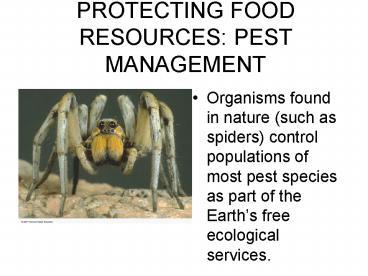PROTECTING FOOD RESOURCES: PEST MANAGEMENT - PowerPoint PPT Presentation
1 / 17
Title:
PROTECTING FOOD RESOURCES: PEST MANAGEMENT
Description:
Integrated Pest Management (IPM) ... SUSTAINABLE AGRICULTURE Three main ways to reduce hunger and malnutrition and the harmful effects of agriculture: ... – PowerPoint PPT presentation
Number of Views:295
Avg rating:3.0/5.0
Title: PROTECTING FOOD RESOURCES: PEST MANAGEMENT
1
PROTECTING FOOD RESOURCES PEST MANAGEMENT
- Organisms found in nature (such as spiders)
control populations of most pest species as part
of the Earths free ecological services.
2
PROTECTING FOOD RESOURCES PEST MANAGEMENT
- We use chemicals to repel or kill pest organisms
as plants have done for millions of years. - Chemists have developed hundreds of chemicals
(pesticides) that can kill or repel pests. - Pesticides vary in their persistence.
- Each year gt 250,000 people in the U.S. become ill
from household pesticides.
3
PROTECTING FOOD RESOURCES PEST MANAGEMENT
- Advantages and disadvantages of conventional
chemical pesticides.
4
Individuals Matter Rachel Carson
- Wrote Silent Spring which introduced the U.S. to
the dangers of the pesticide DDT and related
compounds to the environment.
5
The Ideal Pesticide and the Nightmare Insect Pest
- The ideal pest-killing chemical has these
qualities - Kill only target pest.
- Not cause genetic resistance in the target
organism. - Disappear or break down into harmless chemicals
after doing its job. - Be more cost-effective than doing nothing.
6
Superpests
- Superpests are resistant to pesticides.
- Superpests like the silver whitefly (left)
challenge farmers as they cause gt 200 million
per year in U.S. crop losses.
7
Pesticide Protection Laws in the U.S.
- Government regulation has banned a number of
harmful pesticides but some scientists call for
strengthening pesticide laws. - The EPA, the Department of Agriculture (USDA),
and the Food and Drug Administration (FDA)
regulate the sales of pesticides under the
Federal Insecticide, Fungicide and Rodenticide
Act (FIFRA). - The EPA has only evaluated the health effects of
10 of the active ingredients of all pesticides.
8
What Can You Do?
Reducing Exposure to Pesticides
Grow some of your food using organic methods.
Buy organic food.
Wash and scrub all fresh fruits, vegetables,
and wild foods you pick.
Eat less or no meat.
Trim the fat from meat.
9
Other Ways to Control Pests
- There are cultivation, biological, and ecological
alternatives to conventional chemical pesticides. - Fool the pest through cultivation practices.
- Provide homes for the pest enemies.
- Implant genetic resistance.
- Bring in natural enemies.
- Use pheromones to lure pests into traps.
- Use hormones to disrupt life cycles.
10
Other Ways to Control Pests
- Biological pest control Wasp parasitizing a
gypsy moth caterpillar.
11
Other Ways to Control Pests
- Genetic engineering can be used to develop pest
and disease resistant crop strains.
- Both tomato plants were exposed to destructive
caterpillars. The genetically altered plant
(right) shows little damage.
12
Case Study Integrated Pest Management A
Component of Sustainable Agriculture
- An ecological approach to pest control uses a mix
of cultivation and biological methods, and small
amounts of selected chemical pesticides as a last
resort. - Integrated Pest Management (IPM)
13
Case Study Integrated Pest Management A
Component of Sustainable Agriculture
- Many scientists urge the USDA to use three
strategies to promote IPM in the U.S. - Add a 2 sales tax on pesticides.
- Establish federally supported IPM demonstration
project for farmers. - Train USDA personnel and county farm agents in
IPM. - The pesticide industry opposes such measures.
14
SOLUTIONS SUSTAINABLE AGRICULTURE
- Three main ways to reduce hunger and malnutrition
and the harmful effects of agriculture - Slow population growth.
- Sharply reduce poverty.
- Develop and phase in systems of more sustainable,
low input agriculture over the next few decades.
15
Solutions
Organic Farming
Improves soil fertility
Reduces soil erosion
Retains more water in soil during drought years
Uses about 30 less energy per unit of yield
Lowers CO2 emissions
Reduces water pollution from recycling livestock
wastes
Eliminates pollution from pesticides
Increases biodiversity above and below ground
Benefits wildlife such as birds and bats
16
Solutions Making the Transition to More
Sustainable Agriculture
- More research, demonstration projects, government
subsidies, and training can promote more
sustainable organic agriculture.
17
What Can You Do?
Sustainable Organic Agriculture
Waste less food
Eat less or no meat
Feed pets balanced grain foods instead of meat
Use organic farming to grow some of your food
Buy organic food
Eat locally grown food
Compost food wastes

